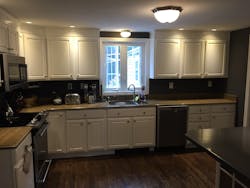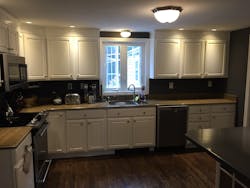Practically Speaking: Kitchen Countertop Conundrum
When it comes to installing receptacle outlets on the walls at countertop surfaces, there seem to be conflicting Code rules. The wall spaces at fixed cabinets having countertops or similar work surfaces, such as the countertops in the kitchen shown in the photo, are not excluded from the wall spaces specified in Sec. 210.52(A)(2). This means that the wall spaces at these cabinets are required to have receptacle outlets installed to satisfy the requirements of Sec. 210.52(A).
At first glance, this may not appear to be a big deal, since there are receptacles outlets installed here to serve the countertop spaces as required by Sec. 210.52(C). However, this is when the conflict arises. Section 210.52(A)(4) specifically states that the “receptacles installed for countertop and similar work surfaces as specified in 210.52(C) shall not be considered as the receptacle outlets required by 210.52(A).” Section 210.52(C) then reiterates this by stating these receptacle outlets “shall not be considered as the receptacle outlets required by 210.52(A).”
So, where should installers put the receptacle outlets needed to satisfy Sec. 210.52(A) requirements? Section 210.52(A)(3) permits receptacle outlets in or on floors to serve as wall space receptacle outlets if located within 18 in. of the wall. This really won’t work because most base cabinets are deeper than 18 in. Section 210.50(A) permits receptacles on cord pendants, but this would be impractical because the cords would interfere with opening and closing the cabinet doors — and I don’t think many homeowners would like the look of cord pendants hanging in their beautiful kitchens. Installing receptacle outlets in the cabinets would not be an option either, since Sec. 210.52(3) states that receptacles in cabinets will not be considered “required” receptacle outlets.
What’s an installer to do to solve this conundrum? One simple Code solution would be to delete Sec. 210.52(A)(4) in its entirety and revise Sec. 210. 52(C) to permit countertop receptacle outlets to also serve as wall space receptacle outlets too. This makes practical sense, and I actually tend to doubt these requirements are being followed or enforced as specifically written anyways. I believe that installers and inspectors are probably accepting the countertop receptacle outlets as the required wall space receptacle outlets too. I recommend installers have a discussion with their AHJ to discuss a practical way to satisfy the requirements for wall space receptacle outlets and countertop receptacle outlets.
About the Author

Russ LeBlanc
Owner
Russ started in the electrical trade as an apprentice in 1985. He worked his way up to become a Journeyman Electrician and then eventually became a Master Electrician and Licensed Construction Supervisor. In 1999 Russ become an Electrical Instructor for The Peterson School of Engineering in Massachusetts where he developed his passion for teaching, and quickly became Department Head of Electrical Instruction. Russ has taught thousands of apprentices, electricians, engineers, inspectors, and other electrical professionals during his career as an instructor. He continues to provide electrical professionals with Electrical Code seminars, Arc-Flash Awareness training seminars and educational material through his LeBlanc Consulting Services in North Reading, MA whose specialty is educating electricians. He has been an active member of the NFPA Electrical Section and has authored hundreds of National Electrical Code proposals and comments which have become Code rules to improve the safety for the electrical industry. Russ is also an IAEI certified Electrical Inspector.
Please visit www.russleblanc.net for more information.

